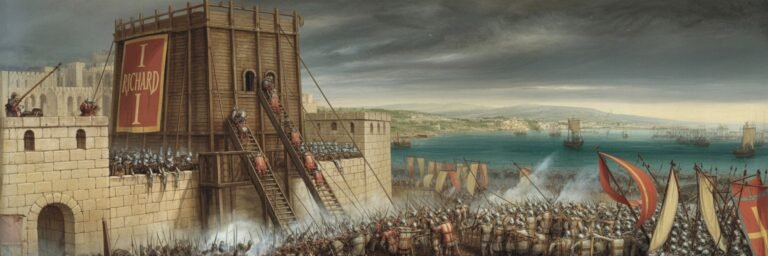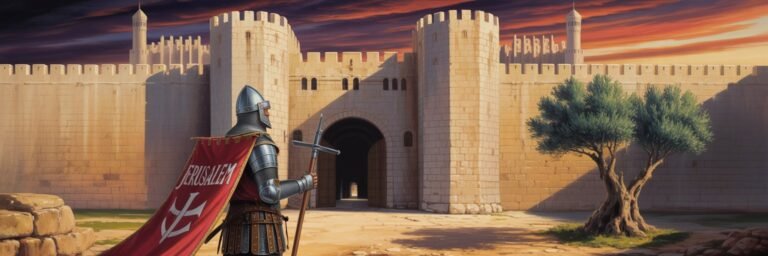INTRODUCTION
As we enlist our hearts within chest of historical events, the Crusades remain one of the most compelling chapters. Fueled by faith and politics, these expeditions from the 11th to the 15th century set the stage for some of the most influential figures in history. This article aims to shine a torchlight on these individuals – kings and sultans, clerics and knights, whose actions shaped the course of the Crusades and reverberate in the echoes of the modern world.
HISTORICAL BACKGROUND
The origin of the Crusades lay entwined in the fabric of religious fervor and geopolitical ambition. Following the advent of Islam, Muslim caliphates had swept across North Africa, Iberia, and importantly, the Holy Land. By the 11th century, Seljuk Turks threatened the Byzantine Empire, prompting Emperor Alexios I to call for help from Pope Urban II. With chant of Deus vult (God wills it), the Pope launched the First Crusade in 1095, igniting a series of religious wars that would last for centuries.
THEORIES AND INTERPRETATIONS
While the mainstream narrative portrays the Crusades as a holy mission to reclaim the Christian Holy Land, scholars have presented alternative theories. Historian Jay Rubenstein views the Crusades as an apocalyptic response to the insecurity and uncertainty of the 11th century. Imminent fear of the Seljuk Turkish threat, the eschatological millennial anxieties, and the changing ecclesiastical landscape, he suggests, conspired to create a fertile ground for a holy war.
Meanwhile, Thomas Asbridge hypothesizes that the Crusaders were more complicatedly driven by a cocktail of social, economic, and religious factors. The promise of indulgences, adventure, and social promotion all served to attract a cross-section of medieval society into these wars.
MYSTERIES AND CONTROVERSIES
Sharp debate continues over figures such as Baldwin IV, the leper King of Jerusalem, and his policies. Some historians laud him as a statesman who sought peace through diplomacy with the Muslims, while others cast him as a naive ruler manipulated by court intrigues.
Similarly, the Siege of Jerusalem in 1099 remains contentious. The triumphant Catholic victors, led by Raymond of Toulouse and Godfrey of Bouillon, are said to have massacred thousands in an unparalleled bloodbath. However, some historians contest these accounts as hyperbolic tales spun by medieval chroniclers, highlighting instead the common practice of bloodshed during city sieges at that time.
SYMBOLISM AND CULTURAL SIGNIFICANCE
Crusader figures such as Richard the Lionheart and Saladin are suffused with cultural symbolism. Richard, the English king renowned for his military prowess, embodies the ideal Christian knight—chivalrous, brave and pious. Saladin, the Kurdish Sultan who recaptured Jerusalem, symbolizes the virtuous Muslim warrior—wise, merciful, and just.
Modern narratives of the Crusades are also informed by contemporary political contexts. For example, Pope Urban II’s call to arms has been linked symbolically with the West’s ‘War on Terror’, with then-President George W. Bush famously invoking the Crusader terminology shortly after 9/11.
MODERN INVESTIGATIONS
Today, archaeologists and historians are tackling centuries-old mysteries linked to the Crusades. Excavations in Israel are unearthing evidence of the Crusaders’ daily life, their agricultural and economic systems, and the endurance of local Eastern Christian communities despite war.
Various hypotheses regarding the motives of the Crusaders are also under examination. For example, a project by the ‘Crusades – Context and Impact’ international research network seeks to unravel the economic background of the Crusaders, exploring whether push-factors such as civil unrest and land shortage in Europe motivated enlistment.
LEGACY AND CONCLUSION
The Crusades indelibly marked the annals of history, leaving a legacy still evident today. It saw the rise of the military orders, such as the Knights Templar, who became bankers of the medieval world, thereby seeding the modern banking system.
Furthermore, the reverberations of the Crusades have shaped East-West relations, continuing to act as a reservoir for political rhetoric, and imbuing Crusader figures with meaning beyond their historical contexts. Richard the Lionheart and Saladin may have become archetypes of their respective cultures, but the reality, like the Crusades themselves, were far more nuanced.
Figures like Raymond, Baldwin, Richard, and Saladin were not just pawns of destiny. They were men of action and faith, driven by their own ambitions and ideals. They navigated political webs, forged alliances and likewise enemies, drew men to battle under their banners, and etched their names into the pages of history. Their influence helped give shape to an era of unprecedented conflict, forging our concept of holy war and the intricate connection between religion and politics. They remain, for better or worse, some of the most influential figures in the pantheon of the Crusades.



